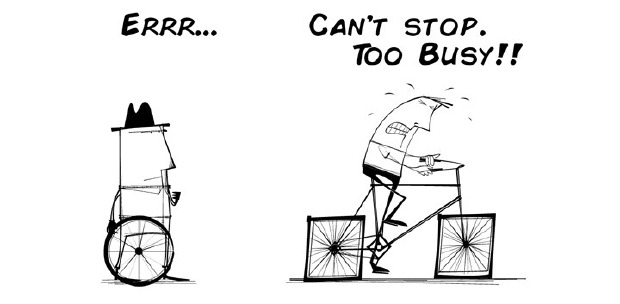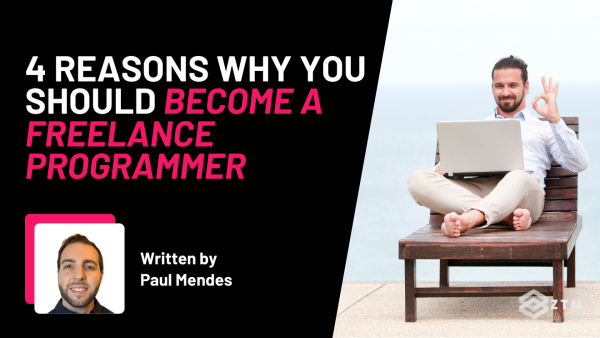I get it, okay?
There are only so many hours in the day.
Between feeding and taking care of ourselves, going to work, struggling with stressful sprints, and trying to learn and stay up-to-date with multiple coding languages, it can feel like there’s no time left to add something new, even if you know deep down that this new thing would be good for you.
And worse?
With all these distractions vying for our attention in our professional lives (bosses, colleagues, sprints, planning meetings, changing technologies, professional development), it’s easy for us to not be present at work or at home.
It’s signal vs. noise, and it’s making us less efficient and less effective when working and studying.
(And we wonder why we suffer from so much stress, anxiety and negative emotions.)
But what if we could hit a soft reset and improve our performance?
What if we could reboot and defrag our brains so that they work more effectively and don’t have runtime errors?
Well that’s what we’re going to talk about today in this article.
Meditation for Programmers: A Beginner's Guide
Because of how hectic our lives are, most people think that they’re “too busy” to meditate but this is actually a framing problem.
What we’re really saying is “we’re too busy to just sit in silence”, because that’s what we think meditation is.
The reality however is that we’re saying we’re too busy to become more productive and focused.
We see meditation as an addition when really it's a streamlining process. We’re so caught up in our current situation that we think the only way out is more effort.

We’re too close to the problem to see the solution, and our usually fantastic analytical processes are not quite functioning at their peak.
Even if we try to fix an issue, sometimes we’re just speeding up the mistake and not removing the root cause.
Trust me, when I say that we’ve all been there, but here’s the thing:
Meditation doesn’t have to be an hour-long, cross-legged, close eyed, praying mantis-hands endeavor.
In fact the highest performers that I know, meditate daily but only for 5-15 minutes max.
The trick to getting started is to reframe your understanding of what meditation really is: a software reboot and defrag.
You simply need to meditate long enough to help close those open tabs in your brain, improve that performance and help you get back on top.
And the reality is, it doesn’t take that long to achieve.
Better still?
Not only will you be more effective and productive after meditating, but often you’ll see better solutions.
In fact, studies have shown that meditation improves your cognitive functions and reduces the size of the fight or flight area of the brain helping to lower stress levels.
(It’s why Google is HUGE on getting their employees to meditate.)
When it really comes down to it, meditation is about focusing on one thing at a time
You’ve probably meditated before without even knowing it. You know when you get into a ‘flow’ and the code is flying through your fingertips and onto the keyboard?
That’s a meditative state.
Your mind becomes singularly focused on the task at hand, removing all other distractions to help you get laser focused.
Suddenly a problem that would have taken days to solve is fixed within hours.
Good news?
It’s possible to get into that flow state on demand, so let’s show you how to go from a slow running processor to kung fu levels of productivity.
How do we start meditating?
Do we need crystals, candles, yoga pants and whale sounds?
Possibly... If that’s what works for you.
The thing is, there are a lot of different meditation techniques, and the best technique for you is simply the one that fits your preferences, time constraints, and lifestyle.
It can be as simple as using an app, practicing controlled breathing or following specific guided meditations for programmers.
The technique and practice itself isn’t as important as getting that end result.
I’m not going to cover every technique today because that would be overwhelming. Instead we’re going to work through 4 steps that you can follow so that you add meditation seamlessly into your daily routine today.
This way you can get started, be more productive and focused and hit that ‘flow’ state where coding feels effortless!
Step 1: Schedule a timeout
Even the Borg needed time for maintenance, so schedule a mindfulness timeout for at least 5 minutes each day.
It’s as simple as that.
No counting your breaths just yet. No sitting cross legged. No praying mantis-hands. Just a timeout.
Program it into your calendar. Now
Just go do this right now. Pick a 5 minute time slot. Set it to repeat every day.
Let’s be honest... what you don’t schedule, doesn’t happen.
(I’m 100% guilty of this ^^)
But you just scheduled it in so that's already a huge step.
This is the most basic step towards you being more focused and productive, so let’s keep it simple and give yourself 5 minutes to just decompress.
That’s all you need at first. Try that for a few days and see how you feel. If possible, try to pick a time slot that will work every day. Being consistent with when you meditate will help you create a daily habit.
Perhaps your 5 minute timeout can take place right before you start your day. Or at lunch as a mid-afternoon break. It can even happen after you clock out from work or school as a way to transition from work to play.
The exact timing is not important - just choose whenever works best for you.
If you’re not a 4am person then don’t try to become one and learn a new habit at the same time. Simply take 5 minutes from your current daily habits instead.
If you have trouble remembering the time you have carved out for yourself, set an alarm to ring each day to remind you to take your break.
💡 Top tip:
Trying to add a new habit can be hard, so a great way to succeed can be to add a new habit on top of an old one. This is sometimes called "Habit Stacking".
For example:
Do you make coffee every morning?
Simply sit and meditate for 5 minutes once you turn the kettle on to boil. This way you always meditate at the exact same time each day, and you can fill that dead time slot with something that can help you instead.
Simple!
Step 2: Find a technique that works for you
Once you’ve spent a few days taking some ‘you time’, now you can add in some defragging/meditation techniques.
But which should you use?
Like we said earlier, there are so many different ways to meditate so instead of going through all of them, I’m going to show you two now and you can pick the one that you think will work best for you.
Technique 1: Control the body, control the mind
Here’s a weird thing about humans:
When we’re stressed, our body becomes tighter and our breathing becomes shallow and sharp.
The goal is to increase oxygen and blood flow for the fight or flight response, but it also floods our systems with cortisol.
The thing is, we can actually cause these same anxious responses, even when there’s no stressful environment. Simply by mimicking anxious breathing patterns we can stress ourselves out.
Crazy right?
The thing is, the opposite is also true.
By controlling and slowing our breathing, we can remove anxiety from situations, and that’s the first technique I want to share with you.
Controlled breathing is one of the best (and easiest) ways to meditate, and all it takes is simply focusing on your breath.
Here's how to do it:
During your 5 minute timeout, sit comfortably with a straight spine. Close your eyes and take in some deep, natural, rhythmic breaths.
- When you’re breathing in, count 1
- When you breathe out, count 2
Continue counting as you breathe in and out.
Once you get to a count of 10, start over at 1 and then repeat this 3x.
It seems simple but you’ll be amazed by how refreshed and present you feel after doing this short exercise.
Technique 2: Visualize a similar experience that you can control
Another easy technique that’s perfect for coders is to imagine a blank computer screen. Really picture it. Visualize it as empty.
If any thoughts try to creep onto your mental screen, imagine yourself deleting them.
Focus on doing this for your 5 minute timeout for a week.
The goal here is that the more you repeat this exercise, the more in control of your thoughts you will be.
Step 3: Engage in mindful eating
Even coders have to stop and eat occasionally, right?
Well when you do (even if it’s just Cup Noodles!), remember that eating can be a meditative experience if approached the right way.
For many of us, mealtime has become a mindless habit where our body is getting fed, while our mind is somewhere else.
We’re either thinking about the next email we have to send, the next task on our To Do list, or mindlessly scrolling social media and so we don’t actually relax.
Practice mindfulness instead!
When meal time comes around, set aside this time so that you can be fully focused on your meal. Tune out everything else around you.
Before you pick up your fork to eat, take a moment to really pay attention to the food you are about to enjoy. Notice the color and shape of your food.
How does it look, smell, and taste? Consciously breathe as you savor every bite.
Bring your full awareness to the sensation of chewing and swallowing. Don’t rush.
This type of eating meditation will help you reset, feel nourished and ready for anything that comes your way for the rest of your day.
Step 4: Wake up and fall asleep consciously
How you start your day will dictate the rest of it.
Waking up is the perfect opportunity to set yourself up to be productive and focused for the day…even if you’re not a morning person.
Use the quiet time you have in bed to enjoy the feeling of your body resting. Take enjoyment in the comfort of your bed, the warm feeling of your blanket against your skin, the cushy pillow that your head rests upon.
Clear your head before you start your day by counting 20 deep breaths in bed.
Don’t check your phone right away, simply count each breath silently to yourself first before doing anything else.
Focus on the sensation as the air enters and leaves your body. Feel your lungs expand and contract.
How you end your day will also influence how you begin the next one
While in bed, think about what you’re thankful for. It can be anything that happened during the day.
It doesn’t have to be something big. You can be grateful for your daily cup of coffee, the clothes on your back or the roof under your head. Or maybe you learned a new technology today, you became a little bit better at coding, a little bit better at solving problems.
The thing is, having a practice of gratitude may seem a bit ‘woo woo’, but it actually affects the dopamine release in our brains, helping us to relax and destress.
Not every day is great and coding can be stressful. But every day has something to be thankful for. Focus on that.
Closing thoughts
So there you have it. 4 steps to help you reboot your brain and be more productive.
Like I said at the outset, meditation is about focusing on one thing at a time.
You could technically be meditating without even knowing it, such as when you are walking or eating and being completely immersed in the act you are engaging in. Or when you’re coding for hours on end, completely immersed in the technological puzzle you’re solving.
That is indeed the amazing thing about meditation. There are many ways to incorporate it into your daily routine so that you can come out feeling re-energized and more at peace.
So now you have no more excuses.
No matter how busy you think you are, you can always find the time to meditate. To focus and be more productive.
It only takes 5 minutes per day. Try it out for a week and see how you feel. Then give it a month and be amazed at the difference it makes.
You won’t regret it.
PS
If you want to dive deeper into meditation and learn numerous new techniques such as Box Breathing, Progressive Muscle Relaxation, and Morning & Evening Meditations, I’ve created a Meditation Guide for Programmers.
It includes a 4 Week Challenge designed to help you make meditation into a habit that you’ll be able to consistently use to be more productive and focused, along with custom guided meditations designed to help you with the most common challenges facing coders, like when you need to relax for a job interview or be motivated to push through a tough sprint.
I've even created a brand new meditation from the Meditation Guide that is specifically designed to help you start being more productive, calm, and focused when going for job interviews!
You can check that out for free by clicking the image below:


![Learning to Meditate [Productivity & Focus]](https://images.ctfassets.net/aq13lwl6616q/2a7NI2zgRFphCk8pnDHBYF/34433f9991c8952427f112d428014bc6/Meditation_Thumbnail_2-_Academy.png?w=600&h=335&q=50&fm=png&bg=transparent)

![Learning to Learn [Efficient Learning]](https://images.ctfassets.net/aq13lwl6616q/6VWcUgLgG0SU55ORlILe2S/e186361aeb48561bcd19ae6486577022/Learning_to_Learn.jpg?w=600&h=336&fl=progressive&q=50&fm=jpg&bg=transparent)


